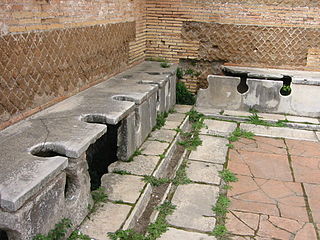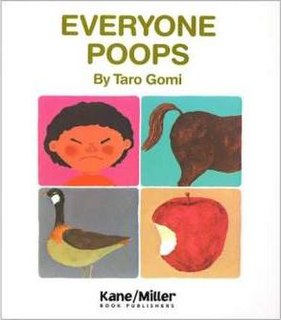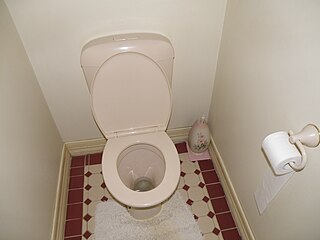Animal toilet may refer to:
- Animal latrine, wildlife dedicated defecation site
- Litter box, pet defecation site
- Animal grooming; see Groom (disambiguation)
Animal toilet may refer to:

Defecation follows digestion, and is a necessary process by which organisms eliminate a solid, semisolid, or liquid waste material known as feces from the digestive tract via the anus. The act has a variety of names ranging from the common, like pooping or crapping, to the technical, e.g. bowel movement, to the obscene (shitting), to the euphemistic. The topic, usually avoided among polite company, can become the basis for some potty humour.
A groom is a male participant in a wedding ceremony.
Crapper is slang term for a toilet.

A latrine is a toilet or an even simpler facility that is used as a toilet within a sanitation system. For example, it can be a communal trench in the earth in a camp to be used as emergency sanitation, a hole in the ground, or more advanced designs, including pour-flush systems.

A portable or mobile toilet is any type of toilet that can be moved around, some by one person, some by mechanical equipment such as a truck and crane. Most types do not require any pre-existing services or infrastructure, such as sewerage, but are completely self-contained. The portable toilet is used in a variety of situations, for example in urban slums of developing countries, at festivals, for camping, on boats, on construction sites, and at film locations and large outdoor gatherings where there are no other facilities. Most portable toilets are unisex single units with privacy ensured by a simple lock on the door. Some portable toilets are small molded plastic or fiberglass portable rooms with a lockable door and a receptacle to catch the human excreta in a container.

Housebreaking or house-training is the process of training a domesticated animal that lives with its human owners in a house or other residence to excrete outdoors, or in a designated indoor area, rather than to follow its instinctive behaviour randomly inside the house.

Everyone Poops is the title of US editions of the English translation of Minna Unchi (みんなうんち), a Japanese children's book written and illustrated by the prolific children's author Tarō Gomi and first published in Japan by Fukuinkan Shoten in 1977 within the series Kagaku no Tomo Kessaku-shū.
There have been many toilet-related injuries and deaths throughout history and in urban legends.

Islamic toilet etiquette is a set of personal hygiene rules in Islam that concerns going to the toilet. This code of Islamic hygienical jurisprudence is called Qaḍāʾ al-Ḥāǧa.
Anal hygiene or anal cleansing refers to hygienic practices that are performed on a person's anus, usually shortly after defecation. Post-defecation cleansing is rarely discussed academically, partly due to the social taboo. The scientific objective of post-defecation cleansing is to prevent exposure to pathogens while socially it becomes a cultural norm. The process of post-defecation cleansing involves either rinsing the anus and inner part of the buttocks with water or wiping the area with dry materials such as toilet paper. In water-based cleansing, either a hand is used for rubbing the area while rinsing it with the aid of running water or pressurized water does the job. In either method subsequent hand sanitization is essential to achieve the ultimate objectives of post-defecation cleansing.
A toilet is a sanitation fixture used primarily for the disposal of human excrement and urine.

A toilet is a piece of sanitary hardware that collects human urine and feces, and sometimes toilet paper, usually for disposal. Flush toilets use water, while dry or non-flush toilets do not. They can be designed for a sitting position popular in Europe and North America with a toilet seat, with additional considerations for those with disabilities, or for a squatting posture more popular in Asia. In urban areas, flush toilets are usually connected to a sewer system that leads to septic tanks in isolated areas. The waste is known as blackwater and the combined effluent including other sources is sewage. Dry toilets are connected to a pit, removable container, composting chamber, or other storage and treatment device, including urine diversion with a urine-diverting toilet.

Humans use one of two types of defecation postures to defecate: squatting and sitting. People use the squatting postures when using squat toilets or when defecating in the open in the absence of toilets. The sitting posture on the other hand is used in toilets that have a pedestal or "throne", where users generally lean forward or sit at 90 degrees to a toilet seat.

A toilet is a small room used for privately accessing the sanitation fixture (toilet) for urination and defecation. Toilet rooms often include a sink (basin) with soap/handwash for handwashing, as this is important for personal hygiene. These rooms are typically referred to as "half-bathrooms".
Animal latrines are places where wildlife animals habitually defecate and urinate. Many kinds of animals are highly specific in this respect and have stereotyped routines, including approach and departure. Many of them have communal, i.e., shared, latrines.

Open defecation is the human practice of defecating outside rather than into a toilet. People may choose fields, bushes, forests, ditches, streets, canals, or other open spaces for defecation. They do so either because they do not have a toilet readily accessible or due to traditional cultural practices. The practice is common where sanitation infrastructure and services are not available. Even if toilets are available, behavior change efforts may still be needed to promote the use of toilets. 'Open defecation free' (ODF) is a term used to describe communities that have shifted to using toilets instead of open defecation. This can happen, for example, after community-led total sanitation programs have been implemented.

Swachh Bharat Mission (SBM), Swachh Bharat Abhiyan, or Clean India Mission is a country-wide campaign initiated by the Government of India in 2014 to eliminate open defecation and improve solid waste management. It is a restructured version of the Nirmal Bharat Abhiyan launched in 2009 and carried out by predecessor Manmohan Singh that failed to achieve its intended targets.
The usual offices is a former euphemism which may refer to either:
Cludgie is Scots for a place to urinate and defecate.
This is a list of Indian states and territories by the percentage of households which are open defecation free, that is those that have access to sanitation facilities, in both urban and rural areas along with data from the Swachh Bharat Mission, National Family Health Survey, and the National Sample Survey. The reliability of this information can be questioned, as it has been observed that there is still open defecation in some states claimed "ODF".